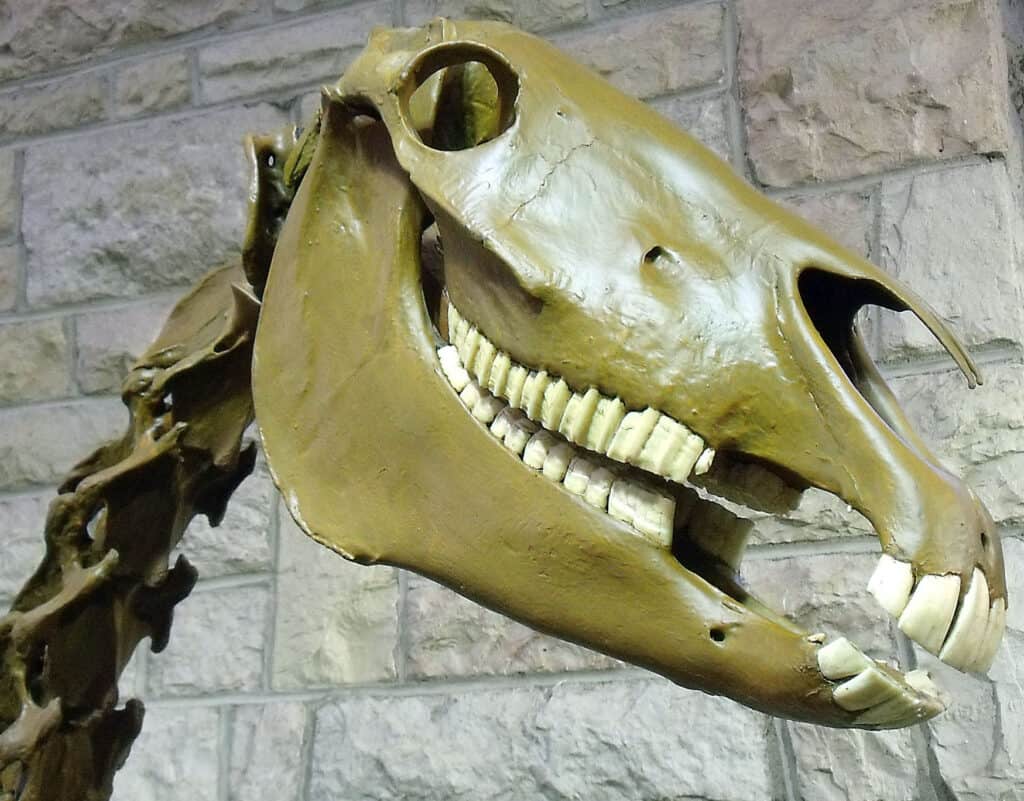Today, there are just over 200 different horse breeds that inhabit the regions around the world. The Shire is currently the largest horse breed, and there are various other draft horses bred to be the largest, and strongest. Across earth’s expansive history, there have lived several giants. Here you will discover the gigantic ancient horse that weighed 3,000 lbs and towered over many of the draft horses today.
Humans and horses have a special relationship, with domestication first occurring around 6000 years ago. Warfare, transportation, and agricultural work are what horses were first used for, and today they are still valuable animals and great pets. Let’s look at the largest known horse fossils ever to be discovered, and what is known about the giant behind them.
Equus Giganteus

Equus giganteus is estimated to have stood at about 7.5 feet tall.
©Mike Beauregard / Creative Commons Attribution 2.0 Generic license. – License
The giant Equus giganteus is an extinct horse species that once roamed North America. This species is estimated to have stood 7.5 feet tall and weighed between 2,600 to 3,300 lbs. The Equus genus has existed for over 5 million years, and many members are alive today, like donkeys, zebras, and modern horses.
Equus giganteus is the largest known species of horse that has been discovered, known by fossil evidence. Called “The Giant Horse” because of their size, Equus giganteus lived during the Blancan period, and it is believed they went extinct around 12,000 years ago during the Pleistocene Epoch.
While very large in size, there is still little known about Equus giganteus. Their mystery lies in the lack of fossil data. Equus giganteus was discovered in North America, living in the range of what is now the United States.
Discovery of Equus giganteus
Fossils of the Equus genus have been regularly discovered in North America since as early as 1826, with discoveries mainly of teeth and vertebrae remains. The variety of the fossils found and how scattered they were made it difficult to identify and distinguish one species from another.
There was much confusion about the horse fossils found in North America until further examination by the American paleontologist Professor Edward Drinker Cope. In-depth examinations of the teeth by looking at the enamel folds, structure, placement in the mouth, size, and other features are what helped identify the remains from one another.
The tooth fossil of Equus giganteus was discovered in Southwestern Texas in Pleistocene beds within the ground. Exceeding over 5 mm in length, the size of the Equus giganteus superior molar was larger than that of any other horse species found, and even the largest draft horses today.
Extinction of Equus giganteus
Due to the lack of fossil evidence of the “Giant Horse,” it is not yet known exactly how this animal became extinct. It is estimated they died off 12,000 years ago, around the same time as other megafauna in North America.
Environmental changes that occurred are one theory on why the giant animals began going extinct. As the climate shifted, so did the vegetation that grew. High protein grasses grew less, while less digestible food flourished, making it harder to sustain large species.
Another factor that may have caused their extinction is humans. The Clovis Tribe lived around 13,000 years ago in North America. While spears tips of this tribe have been found in Texas, there is no evidence yet if they hunted these larger horses. If humans existed with these large animals, it is possible they contributed to their extinction.
Equus giganteus Compared to Other Horses
There are over 200 different types of horse breeds, each with varying sizes. Here are some of the sizes and weights of common horses so you can compare them to the Giant Horses that once roamed North America.
As you will notice, the horse’s height is listed in hands, which is a measurement that has been used since around 3,000 B.C. Measuring in hands was created specifically for horses since there was no standard measurement at the time. Actual hands were used to find their height from foot to shoulder of horses. Equss giganteus is believed to have been 20 to 22 hands tall.
| Horse Breed | Height | Weight |
|---|---|---|
| Shire Horse | 16 to 20 hands | 2,000 to 2,500 lbs |
| Clydesdale | 17 to 19 hands | 1,800 to 2,300 lbs |
| Mustang | 13 to 16 hands | 800 to 1,000 lbs |
| American Quarter Horse | 14.3 to 16 hands | 950 to 1,200 lbs |
| Shetland Pony | 10 to 11 hands | 400 to 450 lbs |
| Miniature Horse | 8.5 to 9.5 hands | 150 to 350 lbs |
| American Paint Horse | 14 to 16 hands | 950 to 1,200 lbs |
| Thoroughbred Horse | 15 to 17 hands | 900 to 1,400 lbs |
Equus giganteus was larger than even the biggest horses of today. While not much is known about this ancient species, with the discovery of more fossils and continued research, there is a lot to be uncovered.
Up Next:
- The Top 13 Biggest Horses in the World
- 10 of the Smartest Horses
- Top 9 Fastest Horses
- 10 Strongest Horses in the World
The photo featured at the top of this post is © Mike Beauregard / Creative Commons Attribution 2.0 Generic license. – License / Original
Sources
- Horse fossil data, Available here: file:///C:/Users/brown/Downloads/B014a09%20(3).pdf
- The stuff of nightmares horse , Available here: https://twilightbeasts.org/2017/07/07/the-stuff-of-night-mares/
- Wiki list of horsres , Available here: https://en.wikipedia.org/wiki/List_of_horse_breeds
Thank you for reading! Have some feedback for us? Contact the AZ Animals editorial team.






